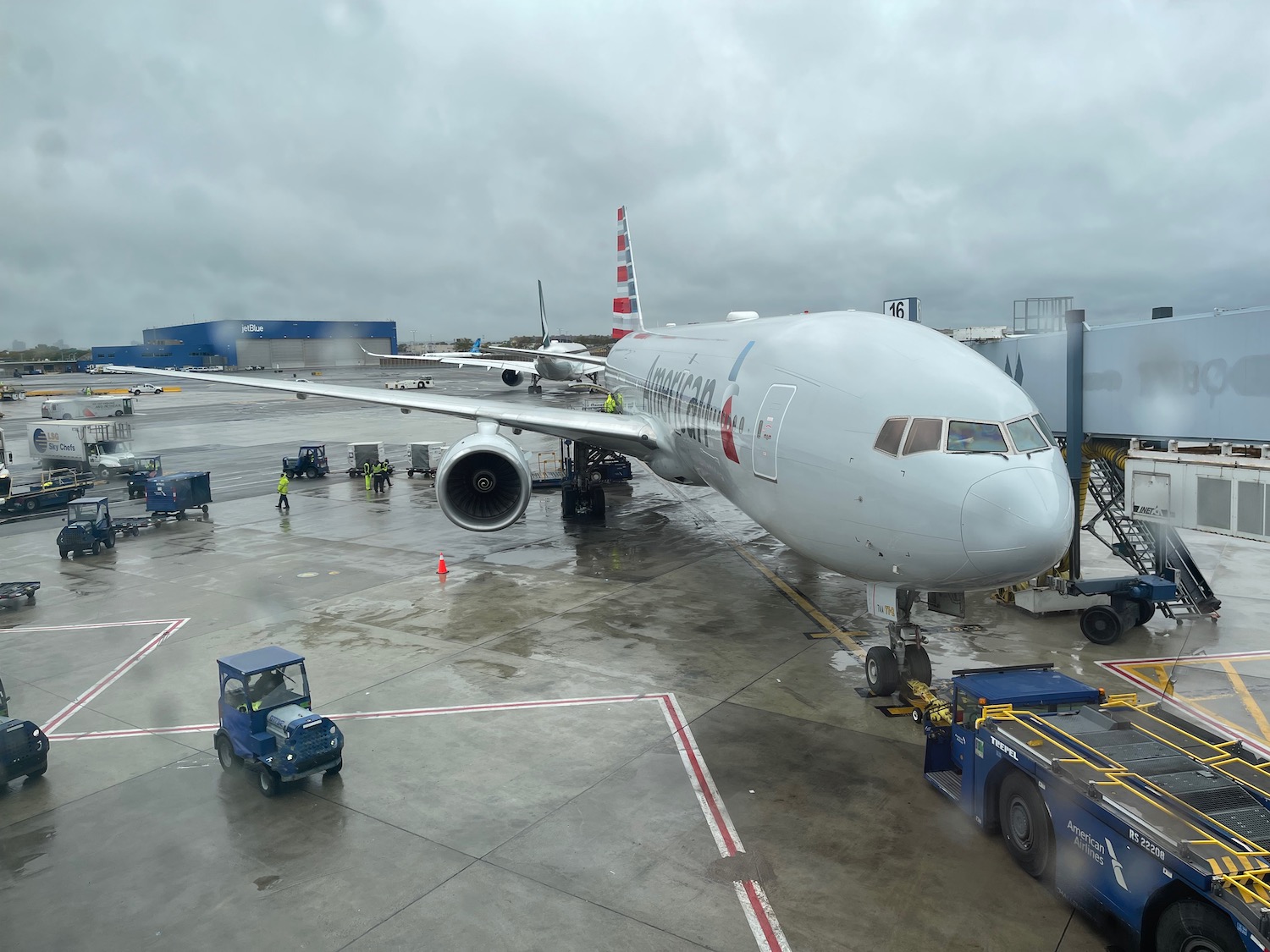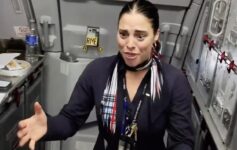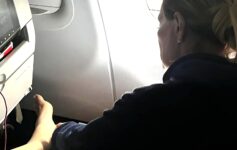
The union representing the American Airlines pilots implicated in the JFK runway incursion incident is trying to downplay pilot culpability through a narrative that defies all reasonableness.
Union Tries To Defend American Airlines Pilots At Heart Of JFK Incident
Running interference through Ted Reed of Forbes, the Allied Pilots Association (APA) lays out a counter-narrative that seeks to absolve the pilots who entered an active runway at New York JFK and put in jeopardy every passenger on their aircraft as well as every passenger on a Delta 737 that was taking off from the same runway they were crossing.
> Read More:American Airlines 777 Nearly Collides With Delta Air Lines 737 – How Could This Happen?
The narrative goes something like this:
First, we warned you something like this would happen!
Indeed, on January 3, 2023 the union complained to its members about a cockpit procedure change that was implemented in writing rather than via (paid) training and impacted some aircraft, including the 777-200 at the heart of this incident.
American Airlines Flight Operations management is attempting to circumvent robust safety-related pilot training by unilaterally imposing operational changes via bulletin. While APA does not oppose fleet harmonization, we are steadfast in our commitment that pilots must be properly trained BEFORE operating with passengers. This training must be developed in a stakeholder safety culture that acknowledges and addresses concerns raised by APA. To date, that has not occurred. This attempt to train by bulletin, while ignoring serious safety concerns and well-established best practices, runs the risk of dramatically eroding margins of safety.
Simply put, management’s actions are unwise and unsafe.
The operational changes that management is attempting to implement without fulsome training alters how pilots communicate, coordinate, and execute flight safety duties at some of the most high-threat times of flight. These high-threat times include, but are not limited to, rejected takeoffs, low visibility approaches, and go-arounds. Aligned and standardized crew communication and coordination is the bedrock of maintaining the safety margin during all phases of flight, but particularly during high task-loaded maneuvers. Management’s attempt to train by bulletin reeks of training on the cheap and placing profits before people.
So what was the procedure change?
First officers must process additional takeoff data (flap and power settings), perform a runway assessment, and mark the cabin takeoff announcement (“flight attendants, prepare for takeoff”). Previously the captain performed these duties, so it is not like there is actually more work to be done in the cockpit.
Notice the union holds out this “see, we we were right” attitude and yet fails to explain how any of these procedures led to such a grievous error. Surely, pilots can walk and chew gum at the same time.
Second, the co-pilot was brand new in her role. Reed writes:
The first officer, an experienced 737 pilot, was making her first 777 flight after 100 hours of training flights that did not include the new procedures.
“She has all this data to analyze and input, plus she has a new task on top of all that,” the source said. “She was overwhelmed.”
That’s not comforting and does not necessarily reflect well on American Airlines or APA either. But it certainly does not reflect well upon the pilot or the captain who should have been watching over her.
Third, the plane took off for London (and overwrote the flight recorder) because the pilots had no idea anything was wrong.
The reason is that they had no knowledge of the seriousness of the incident, the source said. After the incident occurred, controllers gave the pilots a number to call. They called, but it is unclear whether they got through, the source said.
“The crew didn’t understand the gravity of what occurred until they got to London,” the source said. “That is when they realized what happened. Until then, they didn’t know there had been a runway incursion.”
Isn’t it all the more alarming if the three pilots were made aware of a “possible pilot deviation” and parked for 30 minutes and did not seek to understand what was going on?
Fourth, the captain could not see the runway lights.
The captain, meanwhile, had to make a left turn and then a right turn to get on the runway, and so did not have sufficient visibility to see stop bar lights on the runway. The captain was in fact on his way to another runway. A third pilot in the cockpit also could not see the lights.
Yes, apparently sitting in the left seat somehow made the runway lights invisible.
So that’s the union defense. Poor training and a lack of communication concerning the runway incursion.
But here’s what that defense does not answer and what Reed fails to ask:
How could three experienced pilots have taxied to the wrong runway? Even if the captain missed the stop bar lights, did not the other two pilots notice? Were they not checking the flow of traffic?
I’ll doubtlessly be accused of being anti-union, but that is not the case. Here, the problem is that you have three pilots in a cockpit so that six eyes are scanning during taxi, takeoff, and landing, the three most dangerous parts of the flight. Saying the first officer was new or busy does not pass the smell test. Saying that the captain could not see the runway lights really does not pass the smell test.
CONCLUSION
The union narrative on the American Airlines – Delta incident at JFK is that the pilots were not properly trained and had no idea of the severity of the incident. While I do not foreclose that the new procedures may have played into this in an indirect way, I find it a very weak defense that does not exonerate the pilots. Instead, I think Reed’s piece makes the matter even worse for the three AA pilots.




Like anyone accused of wrongdoing, these pilots deserve an opportunity to tell their side of the story and defend their actions. That being said, it is sad to watch unions continually trash their credibility by pushing obvious nonsense in defense of members who appear to have made a serious error.
What side of the story, they don’t have a side they were given clear concise instructions by ATC which they did not follow. They failed to notice they were on the wrong taxiway, they failed to noticed they crossed an active runway with a plane starting its takeoff roll (piloting 101 check the runway environment before you enter or cross any runway to make sure its clear), they then failed to noticed they were line up with the wrong runway.
Listening to the tapes they were told they had just been involved in a deviation and to call the number ATC told them they would listen to the tapes. Why would the captain sit on the ground 30 minutes, decide to takeoff and fly to LHR then claim he had no idea what’s going on? I understand mistakes happen but to takeoff and fly to LHR knowing the cockpit voice recorder would record over everything that was said on that flight deck appears like a deliberate act to cover up the truth of what really was going on on the flight deck on AA that evening.
Yep. But apparently, that makes you and I stupid union haters.
I don’t know what the load factors were on either plane involved but the fact that this incident could have cost over 300 people their lives is reason enough to get to the truth and it appears that the union is more interested in helping the pilots cover up what really happened instead of getting to the truth.
In my opinion on thing the FAA should change immediately when an aircraft is involved in a possible deviation whether on ground or tower frequency that aircraft should be held on the ground and the pilot instructed to immediately return to the gate. What this captain did by taking off after the deviation (then claiming they had no idea any thing happened) should never be allowed to happen again. His decision to take off has single handedly made this investigation and getting to the truth much more difficult.
“Yep. But apparently, that makes you and I stupid union haters.” No, just stupid.
See folks, idiots always prove my point.
Let’s just say many of us were so embarrassed by this union press release when it came out. While we appreciate their hard work when it comes to standing up for better work rules, there’s a time when they need to stay quiet. This particular release makes us seem incompetent for which I find to be insulting to the thousands of professionals for which this union is suppose to represent.
“Yes, apparently sitting in the left seat somehow made the cockpit lights invisible.”
I think you mean, “the runway lights invisible.”
Thanks.
Entirely possible that the IRO, sitting behind the two flying pilots, could not see the runway lights.
I’m very pro-union and will normally defend unions. However, this has the smell of a ton of horse manure. I don’t think Matt is being anti-union at all. When the union comes out with an argument that clearly reeks of blame-shifting and a lack of facing up to reality, it needs to be called out, union or not. The only thing this statement is doing is creating a cover-up so that the pilots (the union’s members) aren’t in the firing line to lose their jobs. Yes, that’s what a union is supposed to be doing. But not this badly.
I just cannot fathom the “the captain didn’t see the lights” defense.
“…defies all reasonableness.”
I know you make typos here and there but, “reasonableness”?
That’s a word. I learned it in law school! 😉
I know JFK very well. When the aircraft had turned and was facing 4L/22R before crossing it, the line-up of aircraft waiting to takeoff from 4L would have been visible out the right hand side windows. Also, the pilots would have seen out the front windows that there were no aircraft ahead of them waiting to takeoff from 31R. Together, that should have indicated that a clarification call to the ground controller was warranted.
The real issue here lies with the fact that these individuals were allowed to continue on to LHR without 2 procedures happening first: 1) Toxicology Reports, why weren’t these individuals screened for drugs and alcohol. 2) No debriefing with the NTSB or even with the FAA was conducted. Hell, even when you as a driver have a near hit with another vehicle that’s too scandalous, the police might choose to conduct a DUI test on you depending the situation. That surely didn’t happen here. Another very disturbing issue here is, witnesses that were onboard the AA plane claim they felt the throttles shoved to their firewall and felt the aircraft sped forward to the point they thought they were about to takeoff. Then the ridiculous captain comes out disingenuously acting oblivious to the fact while claiming he thought he was just supposed to cross the runway. Which, btw, was the WRONG runway anyway. This all according to Jonnyc blogger accounts. Cmon captain, we’re not stupid here, who’s lying and trying to cover stuff up!??!
I agree. While not everyone thinks this could have been Tenerife 2.0, it is still possible that it could have been. Retired JFK controller says there was no chance the Delta plane could have overtaken the AA plane — like Tenerife: https://youtu.be/_LJKqp1BwJw. The fact that this could have been a repeat of that and we don’t have CVR to review is sheer insanity.
To author. You have no idea of actual flight deck ground operations at a congested international airport. “Captain should have been watching over her” I Lmmfao.
The buck stops with the captain. Full stop.
We get it Matt. You hate unions and have zero experience with the subject at hand; thus, who better to lay out a scathing opinion piece? It really wouldn’t have mattered the defense. You just want to make loud noises. Welp, it certainly works for a lot of other village idiots. Proceed. Oh who am I kidding? You’re going to delete this right away. D’awww.
What I hear is a baby crying named Marty who is anything but humble and who has no answer to the content of what I’ve written so he attacks the source. Classy. Keep it up.
I’m surprised that they’re trying to use inexperience of the FO as an excuse. She was an experienced 737 pilot. All the in the cockpit should have seen what was happening rather than owning the airport like my grandma walks through the grocery store.
This event needs to be a stern wakeup call to everyone in the front
Unions do what unions do. No surprise in their response. I would like to read the AA pilots’ response to the incident. I am also curious whether they are currently still flying or are under some sort of mandatory retraining. Disaster was averted thanks to the ATC controller and the immediate reflexes of the DL crew. Instead of assigning blame, the union, management, and involved crew should be doing a situation analysis to avoid this happening again.
I am curious about the “and overwrote the flight recorder.” I would have thought this was outside of any pilot’s control. Was this a deliberate attempt to cover up what happened?
I am not sure of specifics in this case but overall most CVR’s widely used in commercial transportation record audio data for a period of two hours. After that, it overwrites itself. So on any flight you can only hear the cockpit for the past two hours. Knowing these limitations, I’m not sure why this plane continued on. So ‘is this deliberate attempt to cover up what happened’ is possible. I’m sure Mayor Pete is on it. It’s the least we can do to honor the souls lost in Tenerife.
Most likely this is the precise reason they continued. Now we’ll never know what happened, and can never coax the truth out of the mobbed-up unionized pilots. It’s a ln evil thing to do, to betray safety gunfire like that. But they know the union, with all its power, will defend them to the holy no matter how awful they’ve done. And they were right.
Yes, very unfortunate and interesting that the MSM is not even mentioning this piece of them continuing on.
When you mentioned “it’s not like there’s more work to be done in the cockpit” that’s true, but it does change a serious dynamic in the cockpit. There are terms such as “task saturation” and “situational awareness” that need to be considered. If that FO has become task saturated, they are no longer situationally aware during taxi operations. The tasks need to be shared so this doesn’t occur.
It is always easy to judge after the fact with any situation that ends poorly. With that said, the AA crew will most likely be found at fault. As with all accident and incidents there will be a number of contributing factors that contributed to the crew making multiple mistakes and thus the extremely undesirable outcome.
With the information that is available now, my immediate observations as a 17 year airline pilot are as follows:
-AA had made major changes to cockpit procedures the week prior. Normally changes to procedures are trained in simulator or classroom by the airline and at a bare minimum through distance learning curriculum. In fact, the working agreement between AA and their pilots require any changes to procedures to be trained through one of these mentioned methods. AA did not do this. Instead they dropped the changes into the pilot’s electronic manuals and basically said good luck. They even sent out an email to the pilot group that stated “perfection in the use of the new AOM callouts and procedures is not expected or required of you.” Additionally, the AA training department was not consulted in making these changes. Any professional pilot would recognize this as an issue as procedures are carefully choreographed. When another pilot says or does the wrong thing, it is immediately obvious to the other pilot(s) in the flight deck. During the time of transition, the new procedures can easily become the focus and distract from much larger threats (such as crossing a runway). Now this is not an excuse, but most certainly could and probably was a contributing factor. This could have been avoided by AA handling these new procedure changes in a better manner.
-The first officer, while very experienced on other aircraft, was new to the 777. While previous experience certainly transfers over to new aircraft, it takes 3-6 months typically to become comfortable on a new aircraft. This can take even longer on wide body aircraft such as the 777 since significantly less legs are flown per month. When a pilot is new on an aircraft it is very easy to become task saturated and is almost like having blinders on. Again, not an excuse for a professional pilot, but again a contributing factor.
-Per the ATC conversation that can be found on social media, there is a problem with the initial radio call that assigned the AA flight their departure runway. ATC cleared AA properly by stating “American 106 Heavy Kennedy Ground Runway 4L Taxi Left B Hold Short of Kilo.” Now here is where the issues started. The AA pilot read back “B short of K American 106.” The AA pilot should have said at a minimum “4L B Hold Short of K”. Since the AA pilot did not read back the departure runway (which is required) ATC is required to make AA repeat the clearance. They did not. Now did this cause the incident? No, but again another contributing cause. The pilots very well could have been set up for and planning on departing 31L and by not reading back the new departure runway of 4L never realized the plan they had briefed had changed. I would assume expectation bias played a huge role here.
-After the incident and crossing the runway, the AA aircraft was told there was a “possible pilot deviation” and to call a number. Typically this phone call is accomplished after the flight as there is not a traditional phone in the cockpit and personal phones cannot be used per company and FAA policy. After receiving this notification, another voice on the AA flight (presumably the captain) got on the radio and stated that the last clearance he heard was that they had been cleared to cross the runway. ATC told them they had but had crossed the incorrect runway. This goes back to the original radio call that was done incorrectly. It appears the AA crew was expecting 31L and when cleared to cross a runway (despite being a different one) continued to proceed on the expected route. The way the pilot asked the question to ATC leads me to believe they as a crew believed they had clearance to cross the runway they did. This is called expectation bias and can be very powerful when other factors and distractions are happening. ATC did in fact clear AA to cross 31L but the crew crossed 4L, the major event and error in this incident.
Did the AA crew make a large error here that could have resulted in catastrophe? Absolutely. The “how” in how they got there is what interests me and what 1000s of professional pilots will learn from this incident in the future.
Thank you for this interesting comment and insight. I have enjoyed reading NTSB accident reports in the past — not that I want accidents to happen but there is much that can be learned from them. To your point about expectation bias, it is closely related to confirmation bias, which was part of the issue in Tenerife. Calamity and Coincidence: 40 Years Later Are We at Risk of Another Tenerife? https://disciplesofflight.com/remembering-tenerife-airport-disaster/
If you are able to share your opinion on the AA plane continuing on and the lack of CVR data, that would be appreciated.
Expectation bias in this case would stem from the crew expedition a certain runway, not realize the change, and continuing on with the previous plan. Very easy to do especially when distracted by other factors.
In regards to continuing and the CVR…I have no actual info on this but would assuming the crew contacted AA for guidance. This would account for the 30 minute or so delay. They then departed, most likely with AA’s blessing. I doubt they even considered the implications of the CVR here.
Appreciate it, thanks again.
The entire thing sounds like the unions covering up for the pilots’ errors.
Reports from passengers on the AA777 said that they felt the aircraft significantly speed up as it cross the runway (implying that they indeed see the DL speeding towards them and sped up in order to avoid the collision).
In addition, sitting on the taxiway for an additional 30 minutes sounds like they were eating up time on the cockpit voice recorder so that if they had to return to the gate, they would not have audio record of what actually took place inside the cockpit. In other words, erasing the evidence.
Interesting – I have not seen first-hand reports from passengers. I’ll take a look – feel free to post a link if you have one.
The American crew had a total lack of situational awareness (SA). The Captain is totally responsible for every aspect of what goes on in his cockpit. So-called “expectation bias” may be a thing to some, but it never was a thing during my 30 years as an airline pilot. That is an excuse for shit for brains and a total lack of professionalism. Unions are important: they do everything possible to save the careers of the weakest pilots.